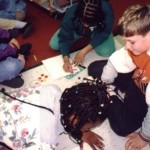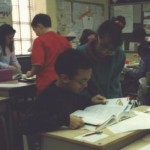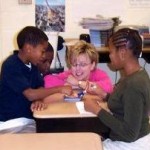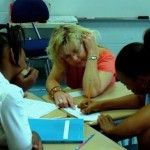“Language permits us to see. Without the word, we are all blind.” –Carlos Fuentes
“Language is not merely a means of expression and communication; it is an instrument of experiencing, thinking, and feeling … Our ideas and experiences are not independent of language; they are all integral parts of the same pattern, the warp and woof of the same texture. We do not first have thoughts, ideas, feelings, and then put them into a verbal framework. We think in words, by means of words. Language and experience are inextricably interwoven, and the awareness of one awakens the other. Words and idioms are as indispensible to our thoughts and experiences as are colors and tints to a painting.” —William Chomsky, Hebrew: the Eternal Language (Philadelphia: Jewish Publication Society, 1957), p.3.
Many students are challenged when solving word problems, not by the procedural contained in the problem, but by the WORDS. One of my students once told me that word problems wouldn’t be such a problem if there weren’t so many words in them. I agreed, but there are many words in mathematics. Knowing those words is one of the keys to problem solving.
This blog contains activities and games that can be used in the math block to make vocabulary come alive. These are perfect for Vivid Vocabulary Instruction during the first part of every day of the Tabor Rotation Structure.
Scenario:
You’re pre-assessing a series of mathematical concepts that will be explored during the next unit. Your class has completed many K-W-L charts, so you want to see what they know in a way that would be more fun, so you introduce your class to Boggle.
Boggle:
• Think of all the words you know about the concept we are about to study.
• In the time given, list these words and/or terms on a sheet of paper.
• Partner up with someone.
• Give yourself one point for every idea they don’t have written.
• With your partner, select the 3 most important words to remember.
• Be ready to share, with the whole group, which words you chose and why.
Scenario:
You and your class are about to spend a week studying geometric shapes. You tell them they will be thinking about the concept writing what they think they know in their math notebooks. To help them to connect to prior knowledge and reflect, you use the four corners structure.
4-Corners
- Move to a corner.
- Think about the reasons why you chose that corner.
- Partner up with someone you do not know and share your reasons.
- Be prepared to share what your partner said.
4-Corner Questions and Choices:
If you had to choose a shape to be for a whole day, which one would it be?
1. Triangle
2. Square
3. Circle
4. Hexagon
If you were a building, which shape would you be?
1. Rectangular Prism
2. Pyramid
3. Cone
4. Cube
Which of the following best describes you?
1. Ray
2. Angle
3. Line
4. Line Segment
Think about everything that occurred in the four corners. Now write in your journal about what we are going to study this week and what you would like to know more about.
Scenario:
You and your class have just completed a week studying fractions. You tell them they will be writing, presenting, and sharing a class book about fractions. The book will be written for students who are anxious about the concept. To help them think and reflect, you use a brainstorming circle.
Brainstorming Circle
- One person talks at a time.
- “Piggy-backing” is allowed and encouraged.
- Only positive responses and facial expressions.
- Practice fluency= answers must be given in three seconds; no repetition of answers
Scenario:
You and your class have just completed studying a topic. You would like for them to be able to summarize what they have learned. To scaffold support, you use the student, non-threatening structure of team webbing.
Team Webbing
- Select a marker from the table.
- Choose a recorder according to the rule.
- Have the recorder write the subject in the center of the web.
- “Web” (think about ideas that relate to the topic and connect them to the web) about the topic.
- Move to a new web and add ideas.
- Return to your “home” web and find 3 interesting themes.
Scenario: Your class has just completed a week of studying area and perimeter of polygons and circles. You want them to place the vocabulary they have learned into long-term memory, so you use music to help them connect.
Mix and Freeze
- List, on an index card, at least 5 terms we used this week when studying math.
- Write, in your own words, what the words mean.
- List at least 2 examples of the words beside your definition.
- When the music starts, mix silently.
- When the music stops, partner up with someone close by and share 2 of the words on your card.
- Continue with a new partner each time the music stops.
- Return to your home group.
- While the music plays, write 10 of the words you remember.
- Use talking chips and share with your group 3 of the words.
Talking Chips
- Write your name on a post-it, an index card, or a poker chip.
- Bring this chip to the discussion circle.
- When you’d like to share with the group, place your chip in the center of the table.
- Continue the discussion with only the ones with chips speaking.
- When all have shared, everyone gets their talking chip back and the process begins again.
Math is full of declarative and procedural knowledge. Using the best strategies you can to help the students make meaning of mathematical vocabulary is invaluable. If a student masters a word and can use it with automaticity, then it’s hers forever. You, as their teacher, have just given them a gift that will live in their minds forever!
“A man has made at least a start on discovering the meaning of human life when he plants shade trees under which he knows full well he will never sit.” -D. Elton Trueblood









